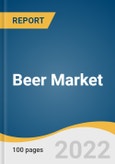The global beer market size is expected to reach USD 1.25 trillion by 2030, registering a CAGR of 7% during the forecast period. The market is expected to be driven by the elevated demand for craft beers. The wide availability and emergence of new brands in this competitive industry are also expected to drive growth.
Despite the overall category's immense size, sales have risen further in recent years, mostly as a result of people trading up, also known as premiumization in the industry, rather than increased consumption. The large-scale availability of budget drinking options has made premium beverages all the more appealing to consumers. These must offer added value and an exciting experience.
Due to the obvious immense popularity of the drink, as well as the vast varieties offered, marketers spend a substantial amount of money on advertising to promote their brands, and this spending has been escalating. According iSpot.tv, the ten largest beer brands in the U.S. spent nearly USD 525.8 million on TV ads in 2021. This has attracted a younger demographic to become consumers of beer and thereby propelled the market growth.
The lager segment held the largest share in 2021 and is expected to sustain its dominance during the forecast period. Due to their low prices and widespread acceptability, lagers are anticipated to dominate the global market. Lagers are produced by most players because they provide a good return on investment. During the forecast period, the others segment, which includes pilsners and non-alcoholic beer, is expected to showcase rapid growth.
The emergence of COVID-19 has led to an increase in off-trade consumption. However, on-trade consumption is expected to showcase faster growth during the forecast period. The growing trend of at-home consumption has boosted the significance of aluminum cans in the packaging segment. Aluminum cans are portable, light-weight, and easy to carry; hence, these are preferred by consumers.
The macro brewery segment dominated the market, commanding more than half the sales value in 2021. The large-scale operations of macro breweries give them a major edge over other segments. Furthermore, the availability of huge capital also increases production volumes, sales, and expenditure on marketing. The market is consolidated in nature, with the major players commanding more than 70% of the overall market in 2021.
Despite the overall category's immense size, sales have risen further in recent years, mostly as a result of people trading up, also known as premiumization in the industry, rather than increased consumption. The large-scale availability of budget drinking options has made premium beverages all the more appealing to consumers. These must offer added value and an exciting experience.
Due to the obvious immense popularity of the drink, as well as the vast varieties offered, marketers spend a substantial amount of money on advertising to promote their brands, and this spending has been escalating. According iSpot.tv, the ten largest beer brands in the U.S. spent nearly USD 525.8 million on TV ads in 2021. This has attracted a younger demographic to become consumers of beer and thereby propelled the market growth.
The lager segment held the largest share in 2021 and is expected to sustain its dominance during the forecast period. Due to their low prices and widespread acceptability, lagers are anticipated to dominate the global market. Lagers are produced by most players because they provide a good return on investment. During the forecast period, the others segment, which includes pilsners and non-alcoholic beer, is expected to showcase rapid growth.
The emergence of COVID-19 has led to an increase in off-trade consumption. However, on-trade consumption is expected to showcase faster growth during the forecast period. The growing trend of at-home consumption has boosted the significance of aluminum cans in the packaging segment. Aluminum cans are portable, light-weight, and easy to carry; hence, these are preferred by consumers.
The macro brewery segment dominated the market, commanding more than half the sales value in 2021. The large-scale operations of macro breweries give them a major edge over other segments. Furthermore, the availability of huge capital also increases production volumes, sales, and expenditure on marketing. The market is consolidated in nature, with the major players commanding more than 70% of the overall market in 2021.
Beer Market Report Highlights
- Asia Pacific held the largest share of the global revenue in 2021, with China accounting for more than 30% share of the regional market. Emerging economies of Vietnam, India, and the Philippines are expected to drive demand during the forecast period.
- Craft breweries are expected to drive growth during the forecast period due to the emergence of regional independent breweries offering strong beers, and the resultant shift in consumer preferences.
- The cans segment is expected to be the fastest-growing packaging segment due to the prevalent at-home consumption patterns, brought about by the outbreak of the pandemic.
Table of Contents
Chapter 1. Methodology and Scope
Chapter 2. Executive Summary
Chapter 3. Beer Market Variables, Trends & Scope
Chapter 4. Consumer Behavior Analysis
Chapter 5. Beer Market: Product Estimates & Trend Analysis
Chapter 6. Beer Market: Packaging Estimates & Trend Analysis
Chapter 7. Beer Market: Production Estimates & Trend Analysis
Chapter 8. Beer Market: Distribution Channel Estimates & Trend Analysis
Chapter 9. Beer Market: Regional Estimates & Trend Analysis
Chapter 10. Competitive Analysis
Chapter 11. Company Profiles
Companies Mentioned
- Anheuser-Busch Inbev
- Heineken
- Carlsberg Breweries A/S
- Molson Coors Beverage Company
- Asahi Group Holdings, Ltd.
- Diageo
- Sierra Nevada Brewing Co.
- United Breweries Ltd.
- Oettinger Brauerei
- China Resources Beer (Holdings) Company Limited
Methodology

LOADING...
Table Information
| Report Attribute | Details |
|---|---|
| No. of Pages | 100 |
| Published | April 2022 |
| Forecast Period | 2022 - 2030 |
| Estimated Market Value ( USD | $ 731.6 Billion |
| Forecasted Market Value ( USD | $ 1250 Billion |
| Compound Annual Growth Rate | 7.0% |
| Regions Covered | Global |
| No. of Companies Mentioned | 10 |









